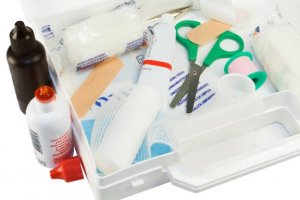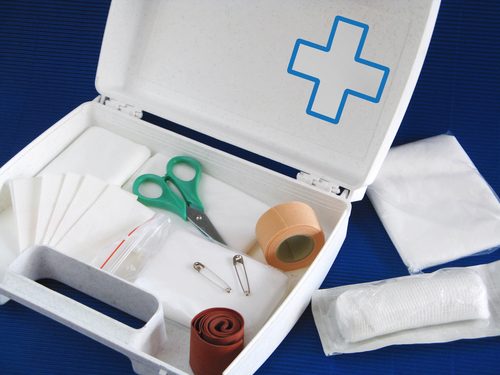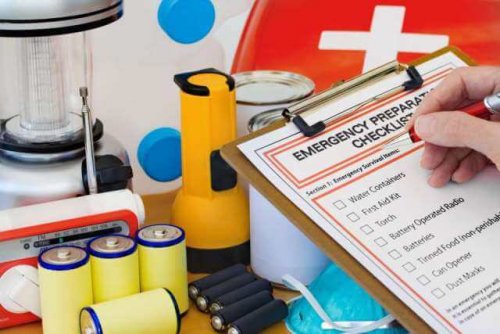What Should Your Home's First Aid Kit Contain?

Don’t wait for a medical emergency to arise before you prepare your home’s first aid kit. From a simple headache to a scrape or upset stomach, these kits offer peace of mind, even if you never use them.
You can replicate your home’s first aid kit for your car or for vacations. The important thing is to periodically check that medications and ointments haven’t expired.
You can buy ready-made first aid kits or assemble your own. For the latter, the following tips will be useful.
How to start assembling your home’s first aid kit
Before moving on to the content, it’s good to first look at the container. The safest and most practical medicine cabinets are usually the case-style ones.
They have handles on the sides and are easy to open and store. As for the material, a transparent hard plastic represents the most suitable option.
Your home’s first aid kit must be resistant and easily stowed and transported. It’s ideal for the interior to be separated by individual modules. Some plastic boxes meant to store art supplies actually make great containers for first aid kits.
Whether stored in a plastic box or a nylon bag, the priority is to have all the medical supplies you need to care for yourself or a family member within easy reach. Whatever the type, the first aid kit should be clearly labeled so that anyone can find it.
What to include in your home’s first aid kit
Although it may depend on your family’s unique circumstances, some common elements for any first aid kit include:
- Antiseptic soap
- Band-aids in various sizes
- Sterile gauze and adhesive bandages in various sizes
- Surgical adhesive tape
- Disinfectant wipes
- Hydrogen peroxide (or similar wound disinfectant)
- Antibiotic ointment
- Hydrocortisone ointment (1%)
- Bandage scissors to cut tape and gauze.

- Tweezers for slivers
- Splints for stabilizing broken bones
- Elastic bandage
- Disposable ice packs
- Thermometer
- Rubbing alcohol
- Calamine lotion
- Common household medications (antihistamines, eye drops, etc.)
- Paracetamol and ibuprofen
- Disposable surgical gloves (2 or 3 pairs)
- Dental preservation kit
- CPR mask (especially if there are older adults in the house)
- Bed sheet
- Lantern or flash light
- Updated first aid manual
- List of emergency telephone numbers
“The safest and most practical first aid kits are usually the case-style ones, with handles on the sides that make them easy to transport and store.”
The importance of having a first aid kit
Everyone in the home should know, within reason considering their age, where the first-aid kit is located. Any babysitters coming to the house should also know the location of the first aid kit.
It’s essential to always keep the first aid kit in the same place. Also, for your children’s safety, it must be in a high place and, preferably, under lock and key.
As for maintenance, your home’s first aid kit must have an inventory list with expiration dates. Some ointments may be used past their expiration date, but they may lose their potency.
On the other hand, once gauze or bandages are used, it’s necessary to immediately replace then with new ones. Thus, maintaining the first aid kit is essential.
Travel first aid kit
In addition to your home’s first aid kit, it’s a good idea to have one you can take with you in the car and on trips. When you travel, you should expand your first aid kit according to your destination.
Sunscreen is essential when going on vacation, as is insect repellent. Ointments for burns and bites shouldn’t be forgotten either.

It’s also a good idea to add rehydration solutions and emergency medications to the kit when you go on vacation. If anyone in your family has an allergy, you must have an epinephrine autoinjector.
Remember to include any medication that must be taken regularly, in addition to everything mentioned in the above list.
In conclusion, your home’s first aid kit guarantees your family can remain as calm as possible in any emergency. From minor burns to serious injuries, toothaches or allergic reactions, the first aid kit will help you immediately apply a remedy.
Don’t hesitate to go to your local pharmacy to complete your home’s first aid kit in just one visit.
Don’t wait for a medical emergency to arise before you prepare your home’s first aid kit. From a simple headache to a scrape or upset stomach, these kits offer peace of mind, even if you never use them.
You can replicate your home’s first aid kit for your car or for vacations. The important thing is to periodically check that medications and ointments haven’t expired.
You can buy ready-made first aid kits or assemble your own. For the latter, the following tips will be useful.
How to start assembling your home’s first aid kit
Before moving on to the content, it’s good to first look at the container. The safest and most practical medicine cabinets are usually the case-style ones.
They have handles on the sides and are easy to open and store. As for the material, a transparent hard plastic represents the most suitable option.
Your home’s first aid kit must be resistant and easily stowed and transported. It’s ideal for the interior to be separated by individual modules. Some plastic boxes meant to store art supplies actually make great containers for first aid kits.
Whether stored in a plastic box or a nylon bag, the priority is to have all the medical supplies you need to care for yourself or a family member within easy reach. Whatever the type, the first aid kit should be clearly labeled so that anyone can find it.
What to include in your home’s first aid kit
Although it may depend on your family’s unique circumstances, some common elements for any first aid kit include:
- Antiseptic soap
- Band-aids in various sizes
- Sterile gauze and adhesive bandages in various sizes
- Surgical adhesive tape
- Disinfectant wipes
- Hydrogen peroxide (or similar wound disinfectant)
- Antibiotic ointment
- Hydrocortisone ointment (1%)
- Bandage scissors to cut tape and gauze.

- Tweezers for slivers
- Splints for stabilizing broken bones
- Elastic bandage
- Disposable ice packs
- Thermometer
- Rubbing alcohol
- Calamine lotion
- Common household medications (antihistamines, eye drops, etc.)
- Paracetamol and ibuprofen
- Disposable surgical gloves (2 or 3 pairs)
- Dental preservation kit
- CPR mask (especially if there are older adults in the house)
- Bed sheet
- Lantern or flash light
- Updated first aid manual
- List of emergency telephone numbers
“The safest and most practical first aid kits are usually the case-style ones, with handles on the sides that make them easy to transport and store.”
The importance of having a first aid kit
Everyone in the home should know, within reason considering their age, where the first-aid kit is located. Any babysitters coming to the house should also know the location of the first aid kit.
It’s essential to always keep the first aid kit in the same place. Also, for your children’s safety, it must be in a high place and, preferably, under lock and key.
As for maintenance, your home’s first aid kit must have an inventory list with expiration dates. Some ointments may be used past their expiration date, but they may lose their potency.
On the other hand, once gauze or bandages are used, it’s necessary to immediately replace then with new ones. Thus, maintaining the first aid kit is essential.
Travel first aid kit
In addition to your home’s first aid kit, it’s a good idea to have one you can take with you in the car and on trips. When you travel, you should expand your first aid kit according to your destination.
Sunscreen is essential when going on vacation, as is insect repellent. Ointments for burns and bites shouldn’t be forgotten either.

It’s also a good idea to add rehydration solutions and emergency medications to the kit when you go on vacation. If anyone in your family has an allergy, you must have an epinephrine autoinjector.
Remember to include any medication that must be taken regularly, in addition to everything mentioned in the above list.
In conclusion, your home’s first aid kit guarantees your family can remain as calm as possible in any emergency. From minor burns to serious injuries, toothaches or allergic reactions, the first aid kit will help you immediately apply a remedy.
Don’t hesitate to go to your local pharmacy to complete your home’s first aid kit in just one visit.
This text is provided for informational purposes only and does not replace consultation with a professional. If in doubt, consult your specialist.








